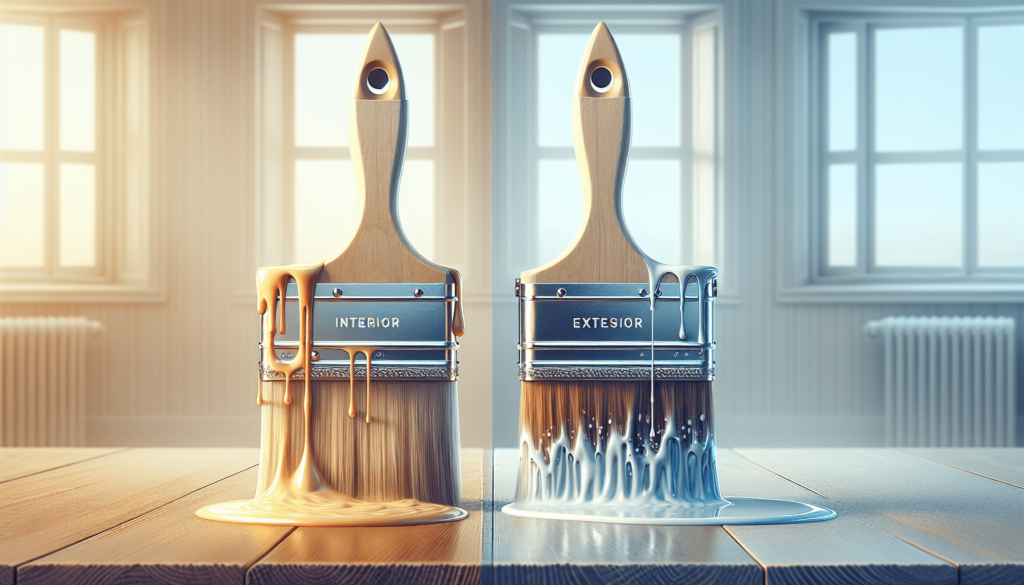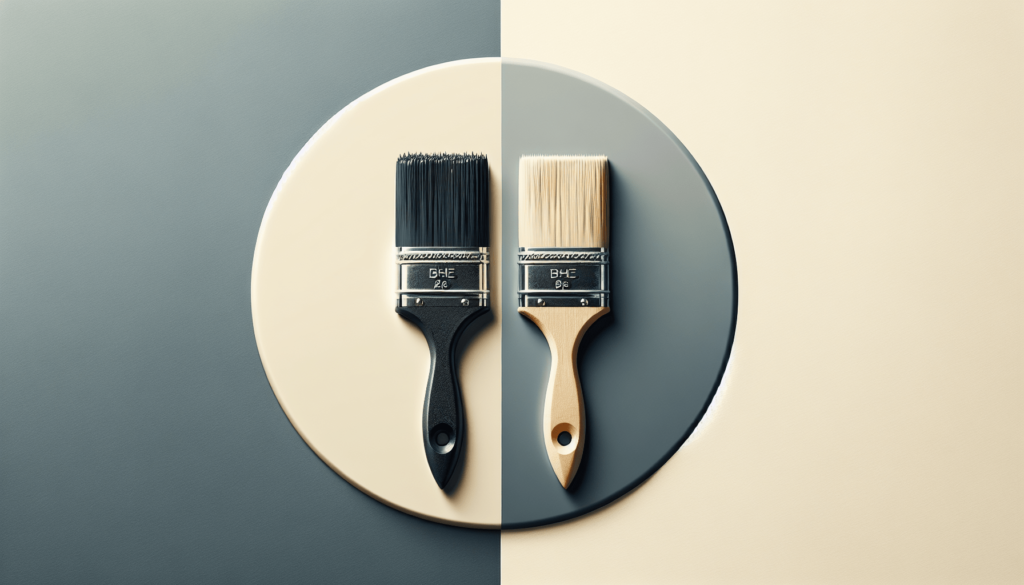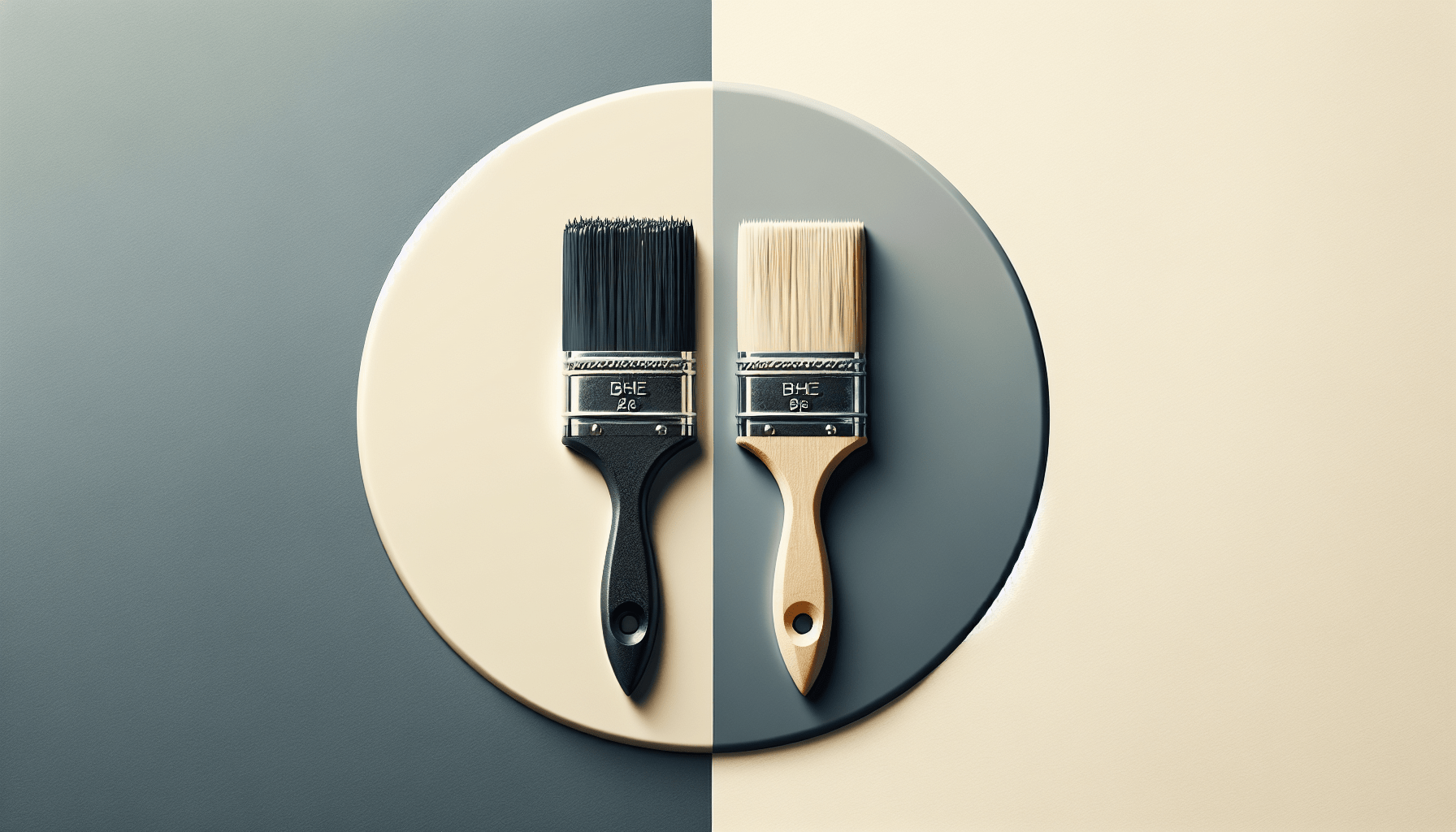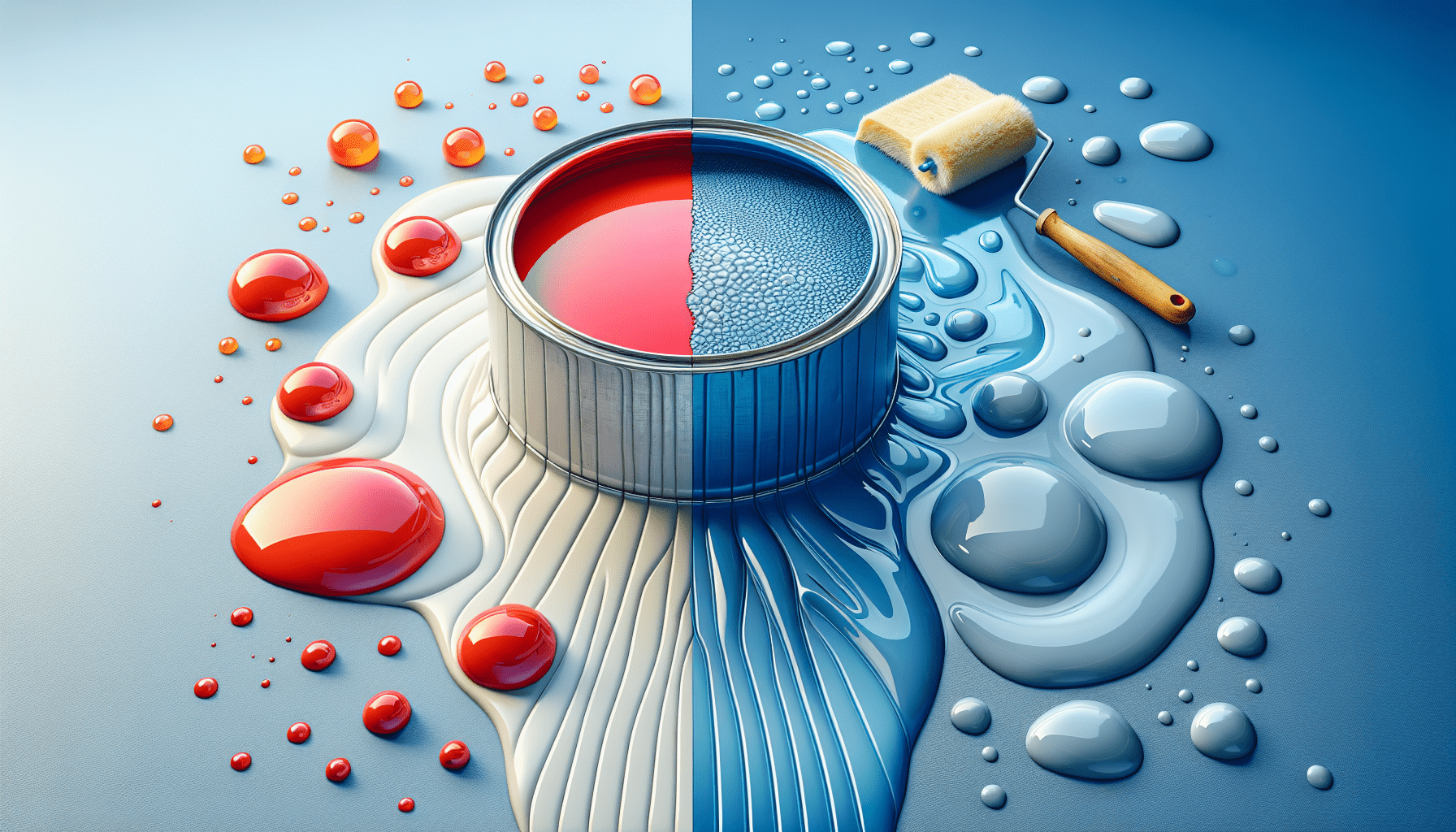In the world of paint, understanding the difference between interior and exterior latex paint is of utmost importance. While both types are based on latex, they are formulated for different purposes and conditions. interior latex paint is designed for use inside the home, providing a durable and washable finish that can withstand the daily wear and tear. On the other hand, exterior latex paint is specially formulated to withstand the harsh outdoor elements, offering superior resistance to fading, cracking, and peeling. By understanding the distinctions between the two, you can make informed decisions when selecting the appropriate paint for your specific project, ensuring long-lasting and aesthetically pleasing results.
Composition
Interior latex paint composition
Interior latex paint is a versatile and commonly used type of paint for indoor applications. Its composition is specifically formulated to provide a durable and attractive finish for interior walls, ceilings, and other surfaces. The key components of interior latex paint include water, binders, pigments, and additives.
The water in interior latex paint serves as the solvent, which allows for easy application and cleanup. This makes it a popular choice for homeowners and professionals alike, as it reduces the need for harsh chemicals and solvents.
Binders in interior latex paint help to hold the pigments together and adhere to the surface. Common binders used in interior latex paint include acrylic, vinyl, or a combination of both. These binders enhance the durability and longevity of the paint and provide excellent adhesion to various surfaces.
Pigments are responsible for adding color to the paint. Interior latex paint is available in a wide range of colors, allowing for endless creative possibilities. These pigments are finely ground particles that are suspended in the paint, ensuring an even and consistent color application.
Additives are often included in interior latex paint to enhance its performance and provide additional benefits. Some common additives include thickeners and leveling agents, which help to prevent drips and ensure a smooth application. Stabilizers may also be added to improve the shelf life of the paint, preventing it from separating or deteriorating over time.
Exterior latex paint composition
Exterior latex paint, as the name suggests, is specifically formulated for use on exterior surfaces. Its composition differs from interior latex paint to withstand the harsher outdoor conditions and provide long-lasting protection against various elements.
Similar to interior latex paint, water serves as the solvent in exterior latex paint, allowing for easy application and cleanup. However, exterior latex paint often contains a higher water content to ensure proper penetration and adhesion to outdoor surfaces.
The binders in exterior latex paint are designed to be more flexible and weather-resistant. This enables the paint to expand and contract with temperature fluctuations, reducing the risk of cracking or peeling. Acrylic or 100% acrylic binders are commonly used in exterior latex paint to enhance its durability and resistance to fading.
Pigments in exterior latex paint are specifically chosen to withstand the damaging effects of sunlight and harsh weather conditions. These pigments are often formulated to resist fading and provide long-lasting color retention, ensuring that the paint maintains its vibrant appearance for years to come.
Additives in exterior latex paint are carefully selected to enhance its protective properties. This may include UV absorbers and stabilizers, which help to protect the paint film from the damaging effects of ultraviolet (UV) rays. Some exterior latex paints may also contain mildewcides or fungicides to prevent the growth of mold and mildew in damp environments.
Durability
Interior latex paint durability
Interior latex paint is designed to withstand the general wear and tear of indoor environments. It offers excellent durability, allowing it to withstand scrubbing, cleaning, and occasional bumps without easily chipping or peeling.
The binders used in interior latex paint contribute to its durability by providing strong adhesion to various surfaces. This ensures that the paint adheres well and remains intact, even in high-traffic areas. The paint film resists cracking or flaking, maintaining its appearance for an extended period.
However, it is important to note that interior latex paint may not offer the same level of durability as exterior latex paint. While it can endure regular cleaning and mild abrasion, it may not hold up as well to the extreme conditions and exposure to the elements that exterior surfaces face.
Exterior latex paint durability
Exterior latex paint is formulated to withstand the harsh outdoor conditions, making it highly durable and long-lasting. It is designed to resist cracking, peeling, and fading, even when exposed to sunlight, temperature changes, and moisture.
The flexible binders in exterior latex paint allow the paint film to expand and contract without cracking or peeling. This is crucial for maintaining the integrity of the paint and protecting the underlying surface from moisture infiltration. The paint’s durability helps to ensure that it remains intact and continues to provide effective protection for the exterior surfaces.
Furthermore, exterior latex paint is engineered to withstand the impact of rain, snow, wind, and other environmental factors. Its composition helps to prevent water intrusion, reducing the risk of damage to the substrate and the growth of mold or mildew.
Overall, the durability of exterior latex paint makes it an ideal choice for painting surfaces exposed to harsh outdoor conditions, such as siding, trim, and fences.

Resistance to Elements
Interior latex paint resistance
Interior latex paint is not specifically formulated to withstand the direct impact of elements like rain, snow, and UV rays. While it provides excellent durability and resistance to normal wear and tear, it may not offer the same level of protection against the elements as exterior latex paint.
Interior latex paint is primarily designed to provide an aesthetically pleasing finish and durability for indoor surfaces. It is meant to withstand cleaning, mild abrasion, and occasional exposure to moisture from activities like cooking and showers. However, prolonged exposure to moisture or extreme humidity can still affect the paint film and potentially lead to peeling or blistering.
Exterior latex paint resistance
Exterior latex paint is specifically engineered to resist the damaging effects of the elements. It is designed to protect the underlying surfaces from moisture, UV rays, and temperature fluctuations.
Exterior latex paint provides a protective barrier against rain, snow, and ice, helping to prevent water infiltration and potential damage to the substrate. Its water-resistant properties minimize the risk of rot, decay, and mold growth in exterior structures.
Additionally, exterior latex paint often contains UV absorbers and stabilizers to protect against the fading and degradation caused by exposure to sunlight. These additives help to maintain the color integrity and overall appearance of the paint, ensuring long-lasting beauty for exterior surfaces.
The resistance to elements offered by exterior latex paint makes it a reliable choice for protecting and enhancing the exterior of buildings, including siding, trim, doors, and windows.
UV Protection
Interior latex paint UV protection
Interior latex paint is generally formulated for use on indoor surfaces, where direct exposure to UV rays is not a significant concern. Therefore, interior latex paint may not contain specific additives to provide UV protection.
While interior latex paint may not offer UV protection, it can still contribute to the overall longevity of the materials it is applied to. By providing a protective coating, interior latex paint helps to shield surfaces from light damage and general wear and tear, extending their lifespan. However, for surfaces exposed to direct sunlight, such as windows or glass doors, it is advisable to choose a specialized UV-protective coating.
Exterior latex paint UV protection
Exterior latex paint is designed with the inclusion of UV absorbers and stabilizers to provide enhanced protection against the damaging effects of sunlight. These additives help to minimize the fading and degradation of the paint film caused by prolonged exposure to UV rays.
UV protection in exterior latex paint is crucial for maintaining the color integrity and overall appearance of exterior surfaces. By reducing the impact of UV rays, it helps to ensure that the paint retains its vibrant colors for an extended period. This is especially important for surfaces that are constantly exposed to sunlight, such as exterior walls, doors, and trim.
The UV protection provided by exterior latex paint contributes to the longevity and aesthetic appeal of outdoor surfaces, allowing for a beautiful and well-maintained appearance over time.

Mildew and Mold Resistance
Interior latex paint resistance to mildew and mold
Interior latex paint is generally not specifically formulated with additives to resist the growth of mildew and mold. However, some interior latex paints may contain mildewcides or fungicides to inhibit the growth of these microorganisms in damp environments.
It is important to note that interior latex paint alone cannot completely prevent the formation of mildew or mold. If the underlying surface is prone to moisture accumulation or lacks proper ventilation, the growth of mildew and mold can still occur. In such cases, addressing the moisture issue and improving ventilation are important steps in preventing mildew and mold growth.
Exterior latex paint resistance to mildew and mold
Exterior latex paint is often formulated with additives that provide increased resistance to mildew and mold growth. These additives, such as mildewcides or fungicides, help to inhibit the growth of these microorganisms in outdoor conditions where moisture may be present.
The resistance to mildew and mold offered by exterior latex paint is particularly important for surfaces exposed to high humidity, such as exterior walls or fences. By preventing the growth of mildew and mold, exterior latex paint helps to maintain the cleanliness and longevity of the painted surfaces, minimizing the need for frequent cleaning or maintenance.
However, it is still essential to address any underlying moisture issues and ensure proper ventilation to prevent the growth of mildew and mold, even with the use of exterior latex paint.
Color Retention
Interior latex paint color retention
Interior latex paint offers excellent color retention, allowing the painted surfaces to maintain their vibrant appearance over time. The pigments used in interior latex paint are selected for their lightfastness and resistance to fading.
While exposure to direct sunlight is not a significant concern for interior surfaces, the color retention of interior latex paint is influenced by other factors such as cleaning and exposure to artificial light sources. Regular cleaning with mild detergents and proper maintenance practices can help prolong the color integrity of interior latex paint.
Additionally, interior latex paints with higher-quality pigments and binders tend to provide better color retention. It is advisable to choose paints from reputable brands that prioritize color quality to ensure long-lasting and vibrant results.
Exterior latex paint color retention
Exterior latex paint is specifically formulated for outdoor use and is designed to offer superior color retention, even in the face of continuous exposure to sunlight, weather conditions, and other environmental factors.
The pigments used in exterior latex paint are selected for their resistance to fading and degradation caused by UV rays. These pigments are specially treated to provide long-lasting color integrity, ensuring that the paint retains its vibrant appearance for extended periods.
UV absorbers and stabilizers included in exterior latex paint further contribute to its color retention properties. By minimizing the impact of sunlight on the paint film, they help to maintain the original color vibrancy over time.
The color retention provided by exterior latex paint is an essential factor in preserving the aesthetic appeal of buildings and outdoor structures, allowing them to look fresh and visually appealing for years to come.
Application Surfaces
Interior latex paint surfaces
Interior latex paint is suitable for a wide range of surfaces commonly found indoors, including:
- Walls: Interior latex paint adheres well to drywall, plaster, and cement walls, providing an even and smooth finish.
- Ceilings: It is commonly used on both textured and smooth ceilings, achieving a seamless and visually pleasing appearance.
- Woodwork: Interior latex paint is well-suited for painting interior wood surfaces such as doors, trim, and cabinets.
- Furniture: It can be used to refresh the appearance of furniture, providing a durable and attractive finish.
- Masonry: Interior latex paint can be applied to masonry surfaces such as concrete floors or fireplace surrounds, offering a decorative touch.
- Metal: Certain types of interior latex paint are formulated for painting metal surfaces, allowing for versatility in design.
The versatility of interior latex paint makes it a popular choice for various indoor applications, providing a reliable and attractive finish to a wide range of surfaces.
Exterior latex paint surfaces
Exterior latex paint is specifically designed for outdoor surfaces, offering excellent adhesion and protection. It is suitable for painting surfaces such as:
- Siding: Exterior latex paint is commonly used to paint various types of siding materials, including wood, vinyl, fiber cement, and aluminum.
- Doors and windows: It can be applied to exterior doors, windows, and frames to protect them from the elements and enhance their appearance.
- Trim and fascia boards: Exterior latex paint offers a durable finish for trim, fascia boards, and other exterior architectural details.
- Porch and deck surfaces: It can be used to paint and protect the surfaces of porches, decks, and outdoor stairs.
- Fences and gates: Exterior latex paint provides an attractive and protective coating for fences and gates, extending their lifespan.
- Outbuildings: It is suitable for painting sheds, garages, and other exterior structures, adding both protection and visual appeal.
The wide range of surfaces that can be painted with exterior latex paint makes it a versatile choice for outdoor projects, ensuring that surfaces are both aesthetically pleasing and well-protected.
Recommended Usage
Interior latex paint recommended usage
Interior latex paint is commonly recommended for:
- Residential properties: It is widely used for painting the interiors of houses, apartments, and condominiums, providing a fresh and visually appealing finish.
- Commercial spaces: Interior latex paint is suitable for various commercial applications, including offices, retail stores, and hospitality venues.
- Schools and educational facilities: It is often used in classrooms, hallways, and common areas in educational settings due to its durability, ease of application, and versatility in color options.
- Healthcare facilities: Interior latex paint is suitable for healthcare environments, such as hospitals and clinics, where cleanliness and hygiene are important factors.
- Institutional buildings: It is commonly chosen for government buildings, museums, libraries, and other public spaces, offering an attractive and durable finish.
The recommended usage of interior latex paint extends to any interior surface requiring a durable and visually appealing coating.
Exterior latex paint recommended usage
Exterior latex paint is recommended for:
- Residential exteriors: It is often used to paint the exteriors of houses, providing protection against the elements while enhancing the curb appeal.
- Commercial buildings: Exterior latex paint is suitable for painting the exteriors of various commercial structures, including offices, retail establishments, and industrial facilities.
- Public infrastructure: It is often used for painting bridges, fences, railings, and other outdoor structures, ensuring their durability and longevity.
- Hospitality and leisure facilities: Exterior latex paint is well-suited for hotels, resorts, and recreational facilities, creating an inviting and visually appealing exterior.
- Educational and healthcare facilities: It is commonly chosen for the exteriors of schools, universities, hospitals, and other institutional buildings, providing long-lasting protection and improving aesthetics.
The recommended usage of exterior latex paint covers a wide range of outdoor surfaces, offering superior protection and enhancing the visual appeal of various structures.
Volatile Organic Compounds (VOCs)
Interior latex paint VOC content
Interior latex paint formulations have evolved to reduce the levels of volatile organic compounds (VOCs) emitted during application and drying. VOCs are carbon-containing compounds that can evaporate into the air and contribute to air pollution and potential health hazards.
To comply with environmental regulations and promote healthier indoor air quality, many manufacturers offer low or zero VOC interior latex paint options. These paints are formulated with significantly reduced levels of VOCs compared to traditional paints. The specific VOC content varies depending on the brand and product, but low or zero VOC interior latex paints typically contain less than 50 grams of VOCs per liter.
Choosing low or zero VOC interior latex paint is particularly important for individuals who are sensitive to strong odors or have respiratory conditions. These paints emit minimal or no odors, making them ideal for use in enclosed spaces, such as bedrooms, living rooms, and offices.
Exterior latex paint VOC content
Similar to interior latex paint, exterior latex paint formulations have also transitioned to reduce the VOC content to promote environmental sustainability and improve air quality. However, exterior latex paint may contain slightly higher VOC levels compared to interior latex paint due to the additional requirements for outdoor performance and durability.
The VOC content in exterior latex paint varies depending on the specific product, brand, and local regulations. Manufacturers strive to provide low or zero VOC options for exterior use, although some paints may contain up to 100 grams of VOCs per liter.
Choosing low VOC exterior latex paint helps minimize the impact on the environment and reduces exposure to potentially harmful chemicals. It is essential to check the specific VOC content and comply with local regulations when selecting exterior latex paint to ensure eco-friendly and sustainable painting practices.
Flexibility
Interior latex paint flexibility
Interior latex paint offers a degree of flexibility that allows it to withstand minor movements and vibrations without cracking or flaking. This flexibility contributes to the durability and longevity of the paint film, ensuring that it remains intact even in environments where slight expansion and contraction may occur.
The binders used in interior latex paint are engineered to provide a balance between adhesion and flexibility. This helps the paint to adhere well to various surfaces and accommodate the normal movements that may occur in buildings, such as temperature changes or settling.
The flexibility of interior latex paint makes it suitable for application on a wide range of interior surfaces, including walls and ceilings, where slight movements may occur over time.
Exterior latex paint flexibility
Exterior latex paint is specifically formulated to be more flexible than interior latex paint. This increased flexibility allows the paint film to accommodate the greater movements and expansions that can occur in outdoor environments due to temperature fluctuations and exposure to the elements.
The binders used in exterior latex paint are designed to provide superior flexibility, reducing the risk of cracking or peeling. This flexibility allows the paint to contract during cooler temperatures and expand during hotter temperatures without compromising its integrity.
The increased flexibility of exterior latex paint makes it a reliable choice for painting exterior surfaces, especially those subject to significant temperature variations or where movement is more pronounced, such as siding or trim.
In conclusion, interior and exterior latex paints differ in their composition, durability, resistance to elements, UV protection, resistance to mildew and mold, color retention, application surfaces, recommended usage, VOC content, and flexibility. Understanding these differences can help you make informed decisions when choosing the appropriate latex paint for your specific application needs. Whether you are looking to paint the interior or exterior of your residential or commercial property, selecting the right latex paint is essential for achieving a durable, attractive, and long-lasting finish.



